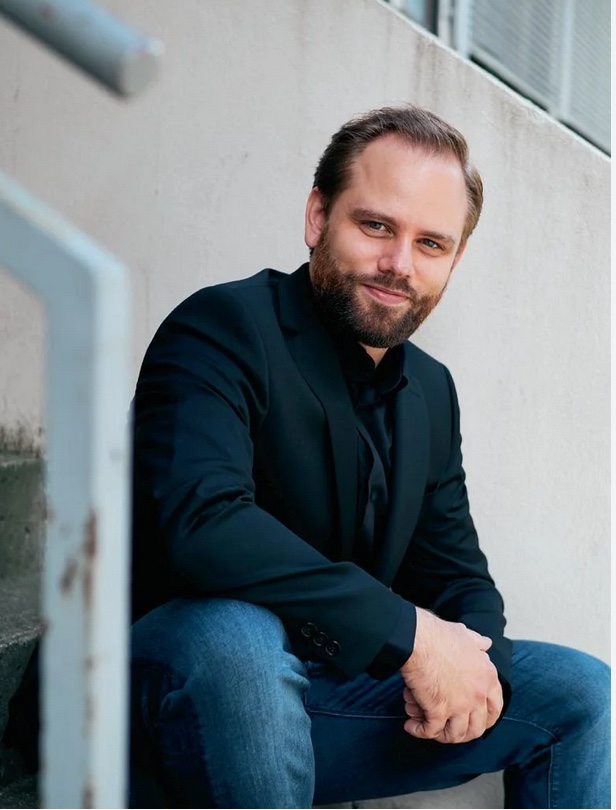by Mike Telin

On Sunday, November 12 at 3:00 pm at Severance Music Center, Daniel Reith will lead the Cleveland Orchestra Youth Orchestra in two well-known works, and two of Reith’s recent discoveries. Tickets are available online.
The concert will open with Johannes Brahms’ Academic Festival Overture. The work was written as a tribute to the University of Breslau, which had awarded him an honorary doctorate in philosophy. And like all good students, Reith said he was happy that the young musicians of COYO are such a curious group.
“Telling them about the origins of the piece really caught their attention,” the conductor said during a Skype conversation. “ I thought it would be fun to do a piece that contains themes of famous student songs of Brahms’ time. And explaining the background to the song about a little fox who is annoying his parents by his curiosity, really fascinated them.”
The afternoon will continue with María Huld Markan Sigfúsdóttir’s Oceans, a work Reith said he discovered through lucky coincidence. “I was searching for pieces on the topic of water for one of our educational concerts last season. Sadly it didn’t fit that program, but it was a wonderful discovery that I thought would be a great piece for COYO.”
Reith said he is happy that his musicians love Oceans as much as he does. “It’s such a wonderful piece, and what I find fascinating about it is the way it draws you into this world of water where no boundaries exist. When I listen to it I lose my relationship with time. So I think it’s psychologically fascinating as well.”
Composed in 2017, the 9-minute work for large orchestra presents opportunities that are not often found in the traditional orchestral canon. “There are certain challenges with each style of music, and this for example, is a piece to train one’s ear to hear all the connections between the instrumental groups in the orchestra. There are also technical aspects like intonation and how to orientate yourself in an advanced harmonic environment. And playing a real pianissimo — that is required in this piece — is not easy. It’s also an intellectual challenge to follow the musical lines as they continuously switch from instrument to instrument.”
Another of Reith’s recent discoveries is composer Walter Piston, and the suite from his ballet The Incredible Flutist.
“When I moved to Cleveland I wanted to become more familiar with American music,” the German-born conductor said. “I knew that Piston played a big role in the academic education of musicians and when I was reading about him, he seemed fascinating and had a very brilliant mind. He first studied engineering, then got into painting, architectural drawing, and after a while into music, and then after studying in Paris, coming back to the U.S. and teaching at Harvard. I just thought, wow, what a personality!”
Reith said that when he was “diving into Piston’s compositions,” he came across The Incredible Flutist and thought it would be great for COYO. “It has such a youthful spirit and something for everybody in the orchestra. The percussion plays a big role and the brass writing is wonderful. And again it has educational aspects for everybody in the orchestra.”
The story takes place at a market square that is full of activity, including a circus. A flutist, who is a snake charmer, also charms women. A rich widow flirts with a merchant, is discovered by her lover, faints, and is revived by the flutist’s music. The circus then leaves the square.
“It has a tonal language that really speaks to the players. There are also some unconventional parts, like the circus march, a dog barking, and the Polka at the end. And we have literally “an incredible flutist” in the orchestra who plays the solo number beautifully.”
Reith said that his decision to program a work as well-known and frequently played as Beethoven’s Symphony No. 5 was a process. Should he or shouldn’t he? Then he put himself into the shoes of a young musician. “I was thinking, for 99% of them it will be the very first time they will play this piece, and because of that this will be a moment to remember in their future musical life.”
Now he’s very happy that he did decide to program the piece.“It’s really energizing for them to play such an iconic work , but there are also a lot of stylistic aspects to talk about. So again there is a strong educational part to it. This entire program is a challenge, but we are investing all of our energy into great pieces of music.”
Published on ClevelandClassical.com November 8, 2023.
Click here for a printable copy of this article



